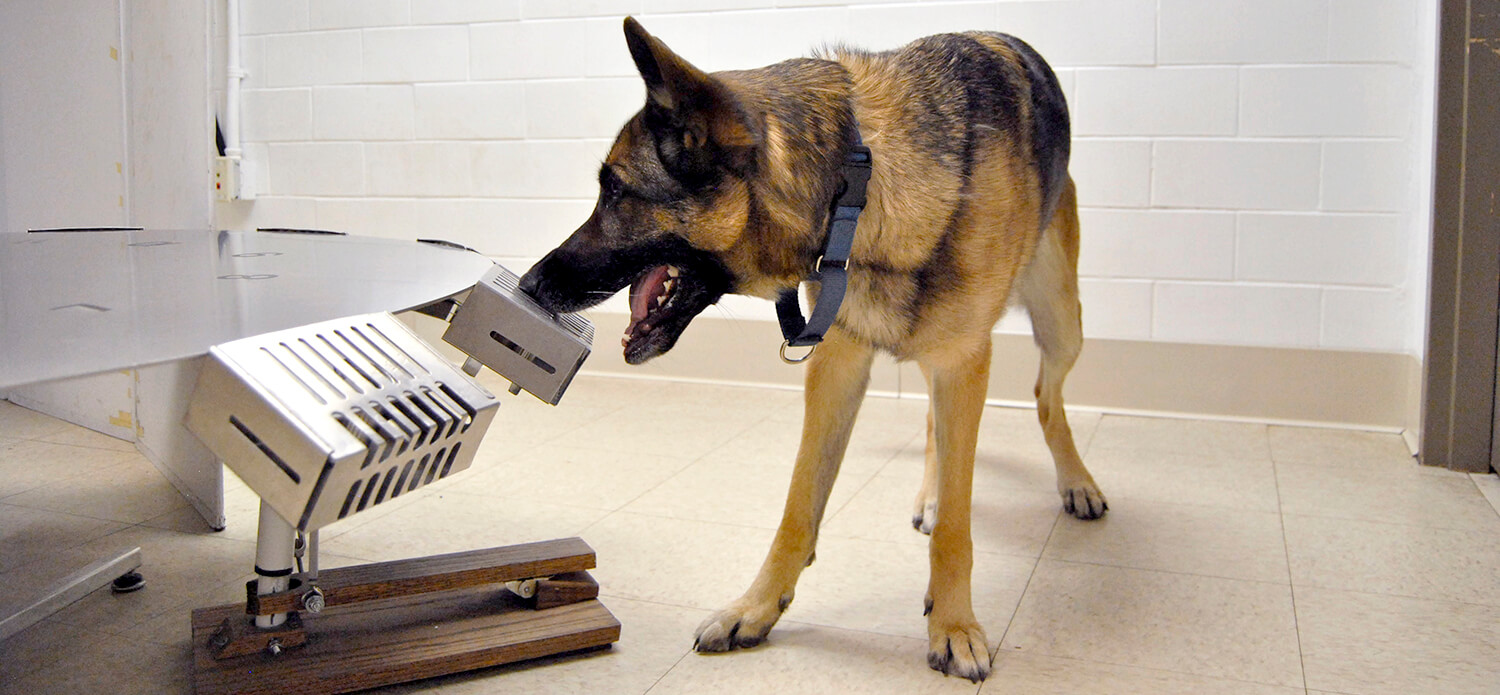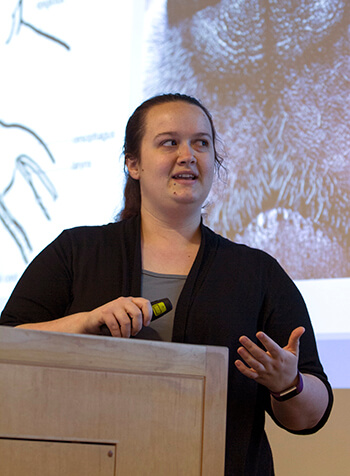 Osa at the scent detection wheel
Osa at the scent detection wheel
Collaboration and innovation are ingrained in Penn’s culture. Guided by this value, one specific University research team is made up of experts in veterinary medicine, obstetrics and gynecology, chemistry, and physics who are working to detect early stage ovarian cancer. While all members are leading experts in their fields, the team’s star talents are humankind’s best friends: dogs.
As part of the Center for Public Health Initiatives’ (CPHI) innovation-themed seminar series, the group’s research—led by Dr. Cynthia Otto, Director of the Penn Vet Working Dog Center; Dr. Janos Tanyi from Perelman School of Medicine’s Division of Gynecologic Oncology; Dr. A.T. Charlie Johnson, Director of the Nano/Bio Interface Center; and Dr. George Preti, an organic chemist at the Monell Chemical Senses Center—was highlighted during the “Detection Dog” talk in April.
 Dr. Jennifer Essler, Postdoctoral Fellow at Penn Vet Working Dog Center, talks about training dogs to detect ovarian cancer.
Dr. Jennifer Essler, Postdoctoral Fellow at Penn Vet Working Dog Center, talks about training dogs to detect ovarian cancer.
The event featured Dr. Jennifer Essler, a postdoctoral fellow at the Working Dog Center who works closely with Otto and Preti. In video and photos, Essler showed how Penn Vet is training dogs, using plasma samples from Tanyi’s patients, to use their incredible sense of smell to detect malignant ovarian cancer.
“Osa is currently the star,” said Essler of the four-year-old German Shepherd featured in a video demo. On screen, the dog sniffed a stainless-steel wheel, outfitted with ports containing a malignant sample, benign samples, and normal samples, as well as a mix of other “distractors.”
Osa suddenly froze and stared. She’d detected the cancer and received a reward. Essler explained how the Working Dog Center is seeing if it can now train dogs on cancer cell lines to alert on cancer plasma, which would reduce the need for increasing numbers of plasma samples.
Preti, an expert on the chemistry of human body odors, discussed his role in applying analytical techniques to identifying the volatile organic compounds (VOCs) in plasma, indicative of ovarian cancer. These VOCs, or odor-producing chemicals, are now being presented to the working dogs.
“Body odor as a diagnostic function has a long history going back to Hippocrates,” said Preti. “And if you think about it, a couple thousand years ago physicians didn’t have much beyond their own senses to diagnose a disease with.”
Today there are sophisticated instruments that can collect, separate, and identify odorants.
“Consequently, the demonstration by the canines that ovarian cancer has an odor signature tells us that we can begin to isolate and identify this odor signature’s components,” he said. “Using the dogs as a sensitive bioassay, the odorants we collect/isolate can be presented to the dogs to see if the isolates’ ‘smell like ovarian cancer.’”
The hope is this research will translate into a device for use in a clinic — essentially, the Working Dog Center dogs are informing and refining what will be an electronic system. That’s where Johnson comes in: The physicist is creating an electronic nose made of nanosensors that mimic the abilities of the canine nose.
The potential impact of a tool that can detect ovarian cancer early is massive. Ovarian cancer is hard to detect at an early stage. At a later stage, it becomes much more difficult to treat — the five-year survival rate of stage-IV ovarian cancer is only 17 percent. If detected in the earliest stages, the cancer is especially treatable, with a five-year survival rate of over 90 percent.
The team’s finding of the past five years are nothing short of “remarkable,” Preti said. “They suggest what we are proposing is not some far-out concept.”
And, better yet, there’s also the potential to use these findings to help detect other “hidden” cancers, specifically pancreatic cancer, which has some genetic similarities to ovarian cancer.
 Dr. George Preti
Dr. George Preti